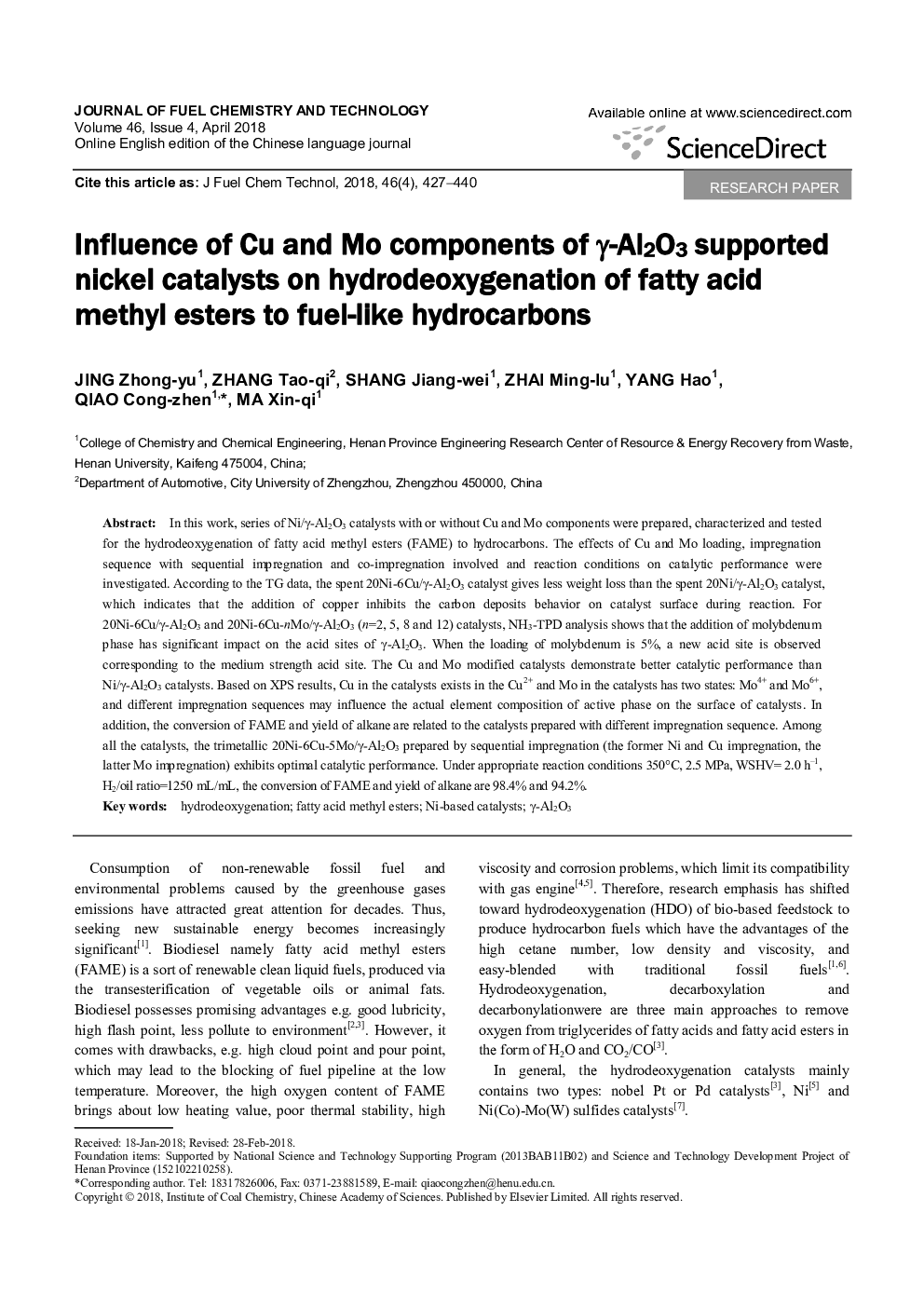| کد مقاله | کد نشریه | سال انتشار | مقاله انگلیسی | نسخه تمام متن |
|---|---|---|---|---|
| 6530565 | 1419877 | 2018 | 13 صفحه PDF | دانلود رایگان |
عنوان انگلیسی مقاله ISI
Influence of Cu and Mo components of γ-Al2O3 supported nickel catalysts on hydrodeoxygenation of fatty acid methyl esters to fuel-like hydrocarbons
دانلود مقاله + سفارش ترجمه
دانلود مقاله ISI انگلیسی
رایگان برای ایرانیان
کلمات کلیدی
موضوعات مرتبط
مهندسی و علوم پایه
مهندسی شیمی
کاتالیزور
پیش نمایش صفحه اول مقاله

چکیده انگلیسی
In this work, series of Ni/γ-Al2O3 catalysts with or without Cu and Mo components were prepared, characterized and tested for the hydrodeoxygenation of fatty acid methyl esters (FAME) to hydrocarbons. The effects of Cu and Mo loading, impregnation sequence with sequential impregnation and co-impregnation involved and reaction conditions on catalytic performance were investigated. According to the TG data, the spent 20Ni-6Cu/γ-Al2O3 catalyst gives less weight loss than the spent 20Ni/γ-Al2O3 catalyst, which indicates that the addition of copper inhibits the carbon deposits behavior on catalyst surface during reaction. For 20Ni-6Cu/γ-Al2O3 and 20Ni-6Cu-nMo/γ-Al2O3 (n=2, 5, 8 and 12) catalysts, NH3-TPD analysis shows that the addition of molybdenum phase has significant impact on the acid sites of γ-Al2O3. When the loading of molybdenum is 5%, a new acid site is observed corresponding to the medium strength acid site. The Cu and Mo modified catalysts demonstrate better catalytic performance than Ni/γ-Al2O3 catalysts. Based on XPS results, Cu in the catalysts exists in the Cu2+ and Mo in the catalysts has two states: Mo4+ and Mo6+, and different impregnation sequences may influence the actual element composition of active phase on the surface of catalysts. In addition, the conversion of FAME and yield of alkane are related to the catalysts prepared with different impregnation sequence. Among all the catalysts, the trimetallic 20Ni-6Cu-5Mo/γ-Al2O3 prepared by sequential impregnation (the former Ni and Cu impregnation, the latter Mo impregnation) exhibits optimal catalytic performance. Under appropriate reaction conditions 350°C, 2.5 MPa, WSHV= 2.0 hâ1, H2/oil ratio=1250 mL/mL, the conversion of FAME and yield of alkane are 98.4% and 94.2%.
ناشر
Database: Elsevier - ScienceDirect (ساینس دایرکت)
Journal: Journal of Fuel Chemistry and Technology - Volume 46, Issue 4, April 2018, Pages 427-440
Journal: Journal of Fuel Chemistry and Technology - Volume 46, Issue 4, April 2018, Pages 427-440
نویسندگان
Zhong-yu JING, Tao-qi ZHANG, Jiang-wei SHANG, Ming-lu ZHAI, Hao YANG, Cong-zhen QIAO, Xin-qi MA,